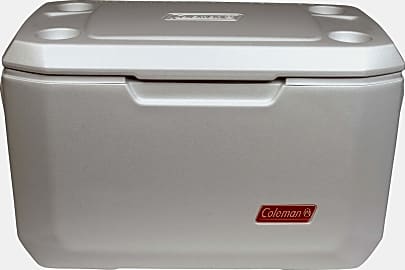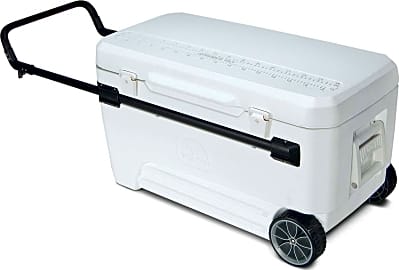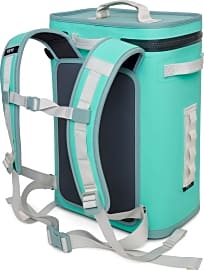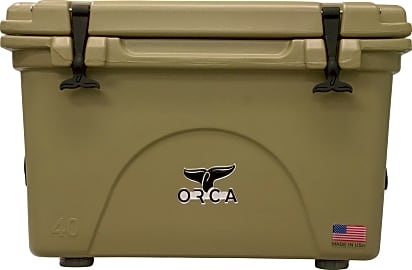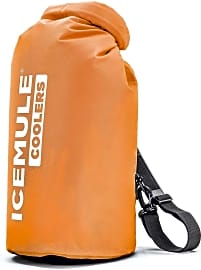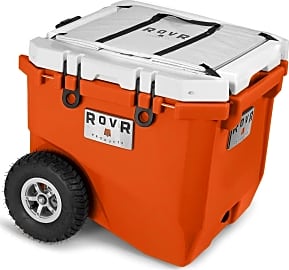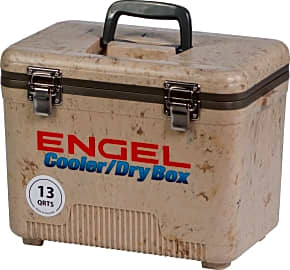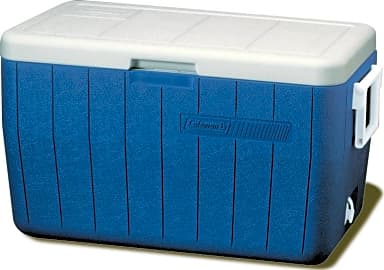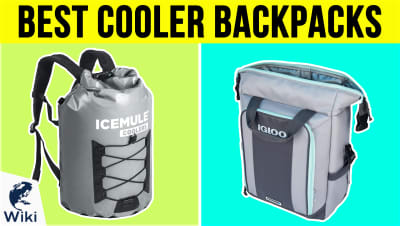The 10 Best Camping Coolers

This wiki has been updated 39 times since it was first published in April of 2015. If you need something that can keep your food and drinks chilled for longer than a picnic or day at the beach, it's time to invest in one of these camping coolers. Built with thick insulation, most of these can maintain ice for days, even in warm temperatures. Depending on the size of your group, you can choose from highly portable to family-sized models with convenient wheels. When users buy our independently chosen editorial choices, we may earn commissions to help fund the Wiki.
Editor's Notes
May 20, 2021:
Because there are so many great coolers to choose from for your next overnight adventure, we removed a soft-sided model from AO Coolers to make way for something a little more high-performing. In its place, we added the Yeti Hopper Backflip 24, which is perfect for hauling cold cuts, vegetables, and beverages short distances. It's especially useful for carrying supplies from your car to campsites on hot days.
Of our former picks, we also upgraded to the Yeti Tundra 45 because it's considerably more versatile than the 35. The 45 remains our top choice. The Rtic 65 is a great choice for larger groups or anyone who wants to store freshly caught fish. If you're on a tight budget, the Coleman Coastal Xtreme is about as affordable as they get, and the Igloo Glide Pro is even bigger, doesn't cost a fortune, and has wheels for convenient hauling.
March 09, 2020:
While the retro styling of the Coleman Belted is impressively eye-catching, the latch tends to be problematic, prompting us to remove it. The Igloo BMX was removed, as well, due to occasional issues with the drain plug. But when it comes to the top choices, you may not be surprised to see the Yeti Tundra 35. Known for its ultra-rugged build, this model is the go-to for all kinds of camping and sporting activities, since it does a fine job of balancing portability with cold retention. We've added the Coleman Coastal Xtreme, also. It doesn't come in the fun colors of the former, but it's less expensive and even has cup holders in the lid. One caveat, however. When left in the rain, the Xtreme can take on water — so be careful about leaving it out in the elements. For those who are truly watching their wallets, we added the Coleman Performance. It simply cannot compete with higher priced, "luxury" choices, like the aforementioned or the Rtic 65, but it won't break the bank and should keep your beer chilled during those overnight trips.
As for smaller, lighter choices, we removed the OAGear Backpack over concerns about its lining, ultimately replacing it with the IceMule Classic. This soft cooler is great for backpackers who, for obvious reasons, cannot carry a big, rotomolded choice; however, it will not keep ice for days and days because of that same lightweight construction. In other words, if you need to cut weight and size, it is a workable cooler backpack, but it can't compete with its larger, hard-walled cousins when it comes to long-term ice retention.
Special Honors
Dometic CFX3 The price tag found on the Dometic CFX3 definitely makes it a luxury choice, as does its battery-powered operation and impressive array of features. Inside each, you'll find two compartments, one for cooling and one for freezing, both incredibly easy to control with the sleek integrated interface or your phone. dometic.com
LionCooler X40A Quit worrying about ice with the LionCooler X40A. A compact unit, it boasts a rechargeable lithium battery that offers up to 10 hours of run time per charge, whether that's via regular AC power or through a solar panel. There's even an app for controlling the temperature with your smartphone. lioncooler.com
Grizzly 100 If you're really going off the grid — say, roughing it for a few weeks in northern Canada or even Alaska — take a look at the Grizzly 100. It is built with thick rubber gaskets for remarkable ice retention, comes with a lifetime warranty, and is certified by the Interagency Grizzly Bear Committee, so you don't have to worry about furry "friends" getting at your grub. grizzlycoolers.com
Planning The Perfect Camping Trip
If you're camping out near your car, however, go ahead and bring all that and more.
When planning a camping trip, the journey defines the gear you'll bring more than the destination. If you're hiking many miles overland, you can't bring a bunch of folding chairs and a boombox and a BBQ grill, no matter how much those items would spruce up the campsite. If you're camping out near your car, however, go ahead and bring all that and more. If you're canoeing downriver to a campsite, feel free to toss a large cooler in the boat, but make sure it's one that seals tightly in case you capsize. And if you're climbing a mountain, make sure you account for every ounce you'll have on your back, because you'll pay for excess weight with lactic acid.
Common sense dictates that you bring enough clothing for potentially cold temperatures and to be changed when soiled, enough water (and/or the ability to purify more) to stay thoroughly hydrated, and proper gear for sleeping in comfort and safety. You also might need headlamps, crampons, ropes, and dozens of other sundries; it's up to you to make sure you have all the gear necessary for the outing at hand.
As for the items you bring camping intended make your trip more fun, that's entirely subjective. Perhaps a guitar is your idea of a campsite commodity, or maybe you want to bring along a few books. Whatever you choose to bring, make sure not to weigh yourself down too much, and make sure to plan out your meals before you start adding in "luxury" items.
Far too often, hikers and campers assemble their gear and think they have an amount of weight they can comfortably carry before they take into consideration the food and water they will also bring. Food weight adds up quickly, and should be your next consideration after you have the basics (as touched on above) covered. And don't forget that along with the weight of the food itself comes the weight of cookware and food storage containers, i.e. the camping cooler.
Choosing A Camping Cooler
If you're hiking overland, a large hard-walled cooler is the wrong choice; if you're car camping or traveling by boat, a hard-walled, cube-shaped cooler is a great choice. Wheeled hard-sided coolers are great for shorter treks, such as the trip down to the beach from the cabin or out onto the docks, but they won't help much at all on longer trails.
As with the rest of your gear, the journey dictates which camping cooler is right for you and which an illogical choice.
As with the rest of your gear, the journey dictates which camping cooler is right for you and which an illogical choice. Backpack style coolers are great for trekking but won't keep foods cold for nearly as long as larger solid coolers, many of which can keep items below 32 degrees Fahrenheit for days.
You will have to make sacrifices when choosing the right camp cooler, just know that going into the process. For hikers, weight is more important than capacity. Choose a smaller, easy-to-carry cooler and plan the parts of your meals that need cooling accordingly. If you're not covering much land, go ahead and bring along a case of brew in an oversized cooler, but know that you'll not be straying far from your campsite with cold food.
A Guide To Great Camp Cuisine
There's no way to make a camping trip more pleasurable (beyond camping with people whose company you enjoy) than by making sure your meals are great. Especially after a long day's hike fueled only by energy bars and beef jerky, a hot, hearty meal makes the perfect end to a day in the field. So too does a warm, filling breakfast fuel you and the team for a long trek, climb, or simply for a great day enjoying the outdoors.
When planning the grain/starch portion of you meals, consider fast-cooking options like couscous or angel hair spaghetti.
As with gear, so too is weight the major consideration when it comes to planning your campsite cuisine. As much as possible, you should plan the protein portion of your meal around meats (or vegetarian equivalents) that require no additional ingredients, e.g. steaks, fish fillets, or pork chops that taste great on their own as opposed burgers or hot dogs that need buns and may necessitate condiments, all of which take up space and add weight.
When planning the grain/starch portion of you meals, consider fast-cooking options like couscous or angel hair spaghetti. Rice or thicker pastas requiring long cook periods are a bad idea unless you plan to cook over a fire, as the extra time needed will drain lots of stove fuel. Bread is not a bad item to bring along if you're not hiking long distances; while bulky, bread isn't heavy. Ultimately, though, dried grain-based foods that are cooked in water are your best bet. There's a reason hikers and mountaineers have long eaten oatmeal, after all, and it's not because all outdoorsmen love the stuff.
And for the record, these ideas for cooking grains only work if you have a readily available source of water and a filter (or iodine tablets) that can ensure it is clean and safe for drinking and cooking.
Vegetables like carrots and dark greens like kale are great campsite eats, as they can be enjoyed cooked or raw. Lettuce or celery has no place in the field, as you get few calories from these veggies; you'll be burning enough energy such that you want highly caloric foods.
As far as condiments to spice up and sweeten your meal, try for hot sauces and soy-based marinades, both of which pack a punch, unlike ketchup or mayo, which must be heaped on to be thoroughly enjoyed.



